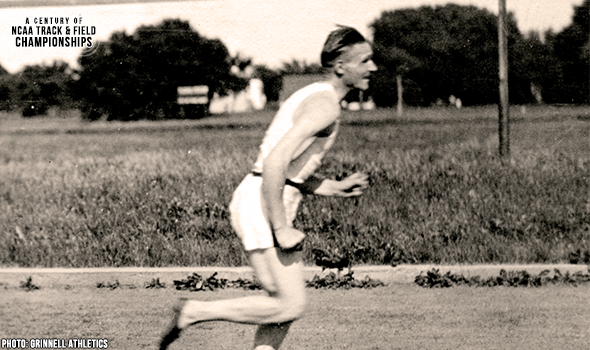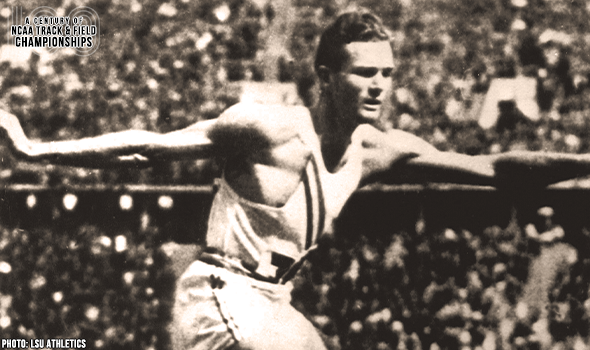
The Tie Goes To The Runner(s)
A dead heat.
On Independence Day, we recognize two service academies – Army and Air Force – that captured their first (and still only) victories by male athletes in this meet 56 years ago. It happened in a thrilling finish in the Men’s 5000 Meters, resulting in the first unintentional* tie for first in a running event in the history of the NCAA Track & Field Championships.
This was 1964, long before technology would make judging close finishes much less time consuming than this one took – several minutes and even then it was only pending until photo negatives could be developed hours later in a trackside room. The final result was a tie between Bill Straub of Army and Jim Murphy of Air Force, both in a meet record time of 14:12.3.
Both Straub, a senior and recently commissioned second lieutenant, and Murphy, a sophomore, were among a select few runners who weren’t doubling back from the 10,000-meter final the day before. The freshness in their legs would become valuable as the race turned into a mad dash on the final homestretch.
Murphy had led for the previous four laps before being passed by Straub and Central Connecticut State’s Jim Keefe going into the last turn. Straub then grabbed the homestretch lead with Murphy finding a second gear. At the finish, Murphy leaned and Straub lunged, tripping over Murphy’s leg.
“I stuck my head out,” Murphy was quoted by United Press International. “I have a habit of doing that in a close race. Sometimes they go on that.”
The Associated Press noted Straub, who tumbled to the ground at the finish, “…needed help off the track, his legs rubbery and his eyes glazed.” Straub later told the AP, “I’m usually sick after a fast last quarter, but not like this.”
Ironically, the very next day the meet had another dead heat in the 400 meters. There has not been a tie for first in any event since at the NCAA DI Outdoor Championships.
Fun fact: Finishing fourth in this race at Hayward Field was an Oregon sophomore named Ken Moore. The Eugene native would become much famous later as Kenny Moore, a two-time Olympic marathoner and the longtime track & field writer for Sports Illustrated. He authored the seminal biography on Bill Bowerman (Bowerman and the Men of Oregon).
*The only other tie for first in this meet in a running event before then came in the 1944 mile, when Michigan twins Robert and Ross Hume intentionally tied. They attempted to do the same in 1945, but Ross was given the win over Robert, both with the same time.
The NCAA and collegiate track & field will mark a momentous milestone in the spring of 2021 -- the 100th anniversary of the NCAA Championships and with that, the NCAA Track & Field Championships. In June 1921, the University of Chicago hosted the first track & field championships in NCAA history.
This point can’t be emphasized enough: Not only was the event the first for NCAA track & field, but the first championships for any sport under the sponsorship of the NCAA.
To celebrate, over each of the next 365 days, the U.S. Track & Field and Cross Country Coaches Association (USTFCCCA) will celebrate moments, student-athletes, and coaches that have made a century’s worth of championships special. From humble beginnings to important historical milestones to the modern-day, collegiate track & field has evolved with the American society.
The 2021 edition of the NCAA Division I Outdoor Track & Field Championships begin with preliminary round action on May 27-29 in Jacksonville, Fla., and College Station, Texas. The championships final site and culmination of the celebration is slated for June 9-12, 2021 at the newly rebuilt Hayward Field in Eugene, Ore.

SIU’s Roggy Dominated The Javelin In 1978
Bob Roggy won the javelin title at the 1978 NCAA DI Outdoor T&F Championships by more than 20 feet. Roggy qualified first for the final with a MR heave of 89.30m (293‑0).

Makusha Made History In Bowerman Year Of 2011
Ngoni Makusha became just the fourth man in meet history to win individual titles in both the 100 and LJ. It was his 3rd career LJ crown and he set a CR in the 100 of 9.89.

George Mason’s Gage Shocked The NCAA LJ In 1988
Nena Gage won the long jump at the 1988 NCAA DI Outdoor T&F Championships in a shocking upset over Gail Devers.

Texas’ Thompson Marveled In NCAA Distance Events
Jerry Thompson won three career distance titles at the NCAA Outdoor T&F Championships. His first came in 1943. Then he won again in 1947 & 1948 after serving in World War II.

Grinnell’s Paulu Sprinted To NCAA History
Leonard Paulu was the first athlete to complete the 100-200 double in NCAA Outdoor Track & Field Championships history in 1922. That also made him the 1st to win back-to-back 100 titles, too.

Scott Won Back-To-Back NCAA Hammer Titles
Candice Scott won back-to-back hammer throw titles at the NCAA DI Outdoor T&F Championships in 2003 & 2004. Scott set a meet record of 69.77m (228-11) in that first year.

Drouin Soared To The Bowerman In 2013
Derek Drouin won two career HJ titles at the NCAA DI Outdoor T&F Championships. When Drouin won in 2013, he was only the fourth man to clear 2.34m (7-8) in meet history.

Watts Made Quick Work Of NCAA 400
Quincy Watts set a meet record in the 400 of 44.00 at the 1992 NCAA DI Outdoor Track & Field Championships. It lasted 25 years until 2017.

Iowa State’s Koll Rolled To 5K-10K Crowns
Lisa Koll won three career titles at the NCAA DI Outdoor T&F Championships in dominant fashion. Her average margin of victory in those 5K & 10K races was 37.73 seconds.

LSU’s Hardin Completed Unique 440-220H Double Twice
The nearly unheard of 440-220H double was so nice that Glenn Hardin did it twice! Hardin became the first to do so in meet history in 1933 and then swept them again in 1934.

